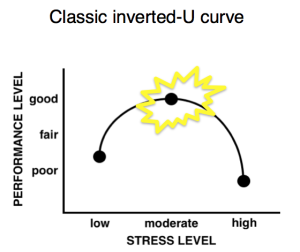This article is based on a talk by Daniela Kaufer, associate professor in the Department of Integrative Biology, for the GSI Teaching & Research Center’s How Students Learn series in Spring 2011.
On this page:
Key Learning Principles
Research Fundamentals
Applications to Teaching
Further Reading
Also available:
Video and full summary of Daniela Kaufer’s talk “What Can Neuroscience Research Teach Us about Teaching?”
Key Learning Principles
- From the point of view of neurobiology, learning involves changing the brain.
- Moderate stress is beneficial for learning, while mild and extreme stress are detrimental to learning.
- Adequate sleep, nutrition, and exercise encourage robust learning.
- Active learning takes advantage of processes that stimulate multiple neural connections in the brain and promote memory.
Research Fundamentals
Changing the brain: For optimal learning to occur, the brain needs conditions under which it is able to change in response to stimuli (neuroplasticity) and able to produce new neurons (neurogenesis).
The most effective learning involves recruiting multiple regions of the brain for the learning task. These regions are associated with such functions as memory, the various senses, volitional control, and higher levels of cognitive functioning.
 Moderate stress: Stress and performance are related in an “inverted U curve” (see right). Stimulation to learn requires a moderate amount of stress (measured in the level of cortisol). A low degree of stress is associated with low performance, as is high stress, which can set the system into fight-or-flight mode so there is less brain activity in the cortical areas where higher-level learning happens. Moderate levels of cortisol tend to correlate with the highest performance on tasks of any type. We can therefore conclude that moderate stress is beneficial for learning, while mild and extreme stress are both detrimental to learning.
Moderate stress: Stress and performance are related in an “inverted U curve” (see right). Stimulation to learn requires a moderate amount of stress (measured in the level of cortisol). A low degree of stress is associated with low performance, as is high stress, which can set the system into fight-or-flight mode so there is less brain activity in the cortical areas where higher-level learning happens. Moderate levels of cortisol tend to correlate with the highest performance on tasks of any type. We can therefore conclude that moderate stress is beneficial for learning, while mild and extreme stress are both detrimental to learning.
Moderate stress can be introduced in many ways: by playing unfamiliar music before class, for example, or changing up the format of discussion, or introducing any learning activity that requires individual participation or movement. However, people do not all react the same way to an event. The production of cortisol in response to an event varies significantly between individuals; what constitutes “moderate stress” for one person might constitute mild or extreme stress for another. So, for example, cold-calling on individual students in a large-group setting might introduce just the right amount of stress to increase some students’ performance, but it might produce excessive stress and anxiety for other students, so their performance is below the level you know they are capable of. Any group dynamic that tends to stereotype or exclude some students also adds stress for them.
Adequate sleep, good nutrition, and regular exercise: These common-sense healthy habits promote optimal learning performance in two ways. First, they promote neuroplasticity and neurogenesis. Second, they keep cortisol and dopamine (stress and happiness hormones, respectively) at appropriate levels. All-night cramming sessions, skipped meals, and skipped exercise can actually reduce the brain’s capacity for high academic performance. (This is true for instructors as well as students.)
 Active learning: Cognitive functions associated with the lower levels of Bloom’s taxonomy (see diagram at left), such as understanding and remembering, are associated with the hippocampus (the area of the brain responsible for memory and spatial awareness). The higher-level cognitive functions of Bloom’s taxonomy, such as creating, evaluating, analyzing, and applying, involve the cortical areas responsible for decision-making, association, and motivation.
Active learning: Cognitive functions associated with the lower levels of Bloom’s taxonomy (see diagram at left), such as understanding and remembering, are associated with the hippocampus (the area of the brain responsible for memory and spatial awareness). The higher-level cognitive functions of Bloom’s taxonomy, such as creating, evaluating, analyzing, and applying, involve the cortical areas responsible for decision-making, association, and motivation.
More complex thought processes are more beneficial for learning because they involve a greater number of neural connections and more neurological cross-talk. Active learning takes advantage of this cross-talk, stimulating a variety of areas of the brain and promoting memory.
Applications to Teaching
Classroom Activities, from the Teaching Guide for GSIs
Some Basic Active Learning Strategies, from the University of Minnesota Center for Educational Innovation
Further Reading
Please note that some links may require Library proxy access. Please see the Library’s page Connect from Off Campus.
Blakemore, Sarah-Jayne and Uta Frith (2005). The Learning Brain: Lessons for Education. Malden, MA: Blackwell.
Felder, Richard M. and Rebecca Brent (1996). “Navigating the Bumpy Road to Student-Centered Instruction.” An abridged version of this article was published in College Teaching 44: 43–7.
Tokuhama-Espinosa, Tracey (2011). Mind, Brain, and Education Science: A Comprehensive Guide to the New Brain-Based Teaching. New York: W. W. Norton.
Walker, J. D. et al. (2008). “A Delicate Balance: Integrating Active Learning into a Large Lecture Course.” CBE Life Sciences Education 7.4: 361–67.
Winter, Dale et al. (2001). “Novice Instructors and Student-Centered Instruction: Identifying and Addressing Obstacles to Learning in the College Science Laboratory.” The Journal of Scholarship of Teaching and Learning 2.1: 14–42.